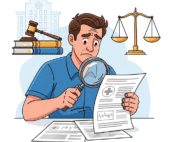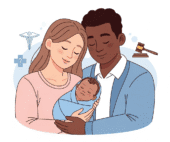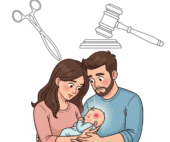While Cerebral Palsy (CP) is primarily known as a motor disorder, the brain injury that causes CP can also impact sensory functions, particularly vision and hearing. For families, understanding these potential co-occurring impairments is crucial for early identification, appropriate intervention, and maximizing a child’s developmental potential and quality of life.
This article explores the types of vision and hearing impairments commonly associated with Cerebral Palsy, explains why these sensory issues occur, highlights the importance of early detection, and discusses strategies for support and management.
Vision Impairments in Children with Cerebral Palsy
Visual problems are more common in children with CP than in the general population. These impairments can range from mild to severe and can significantly impact learning, mobility, and social interaction.
Common Vision Impairments in CP
- Strabismus (Crossed or Wandering Eyes): A misalignment of the eyes, often due to muscle weakness or poor neurological control. This can interfere with depth perception and binocular vision.
- Nystagmus (Involuntary Eye Movements): Rapid, repetitive, and uncontrolled eye movements that can affect visual acuity and tracking.
- Refractive Errors (Nearsightedness, Farsightedness, Astigmatism): These common vision problems occur when the shape of the eye doesn’t focus light correctly on the retina, leading to blurry vision.
- Cortical Visual Impairment (CVI): A neurological condition where the brain has difficulty processing visual information despite the eyes themselves being healthy. This is a significant cause of vision impairment in children with CP, often resulting from the same brain injury that caused the motor difficulties.
- Optic Nerve Atrophy: Damage to the optic nerve, which transmits visual information from the eye to the brain, leading to reduced vision.
- Visual Field Defects: Loss of vision in certain areas of the visual field.
Hearing Impairments in Children with Cerebral Palsy
Hearing loss can also occur in children with CP, although it may be less prevalent than vision impairments. Early identification and management are vital for language development and communication.
Common Hearing Impairments in CP
- Sensorineural Hearing Loss: Damage to the inner ear or the auditory nerve, often resulting from the same neurological insults that cause CP, such as prematurity, low birth weight, or infections.
- Conductive Hearing Loss: Problems with the outer or middle ear that prevent sound from reaching the inner ear. While less directly linked to the brain injury of CP, it can still occur in this population.
- Auditory Processing Disorder (APD): A condition where the brain has difficulty processing auditory information, even when hearing sensitivity is normal. Children with CP may be at a higher risk for APD due to neurological differences.
Why Vision and Hearing Assessments are Crucial
Early detection of vision and hearing impairments in children with CP is paramount because:
- Early Intervention: Addressing sensory issues early can significantly impact a child’s development in areas such as language, motor skills, and social interaction.
- Educational Access: Appropriate accommodations and assistive devices can ensure that visual and auditory impairments do not hinder a child’s ability to learn.
- Safety and Independence: Good vision and hearing are essential for navigating the environment safely and promoting independence.
- Communication: Clear vision and hearing are fundamental for effective communication and building relationships.
- Differential Diagnosis: Sometimes, sensory impairments can be mistaken for behavioral or cognitive issues. Accurate assessment helps in proper diagnosis and intervention.
Strategies for Support and Management
A multidisciplinary team approach is essential for managing vision and hearing impairments in children with CP. This team may include:
- Ophthalmologists: To diagnose and treat eye conditions, prescribe glasses or contact lenses, and recommend therapies.
- Audiologists: To assess hearing, fit hearing aids or other assistive listening devices, and recommend communication strategies.
- Developmental Pediatricians: To oversee the child’s overall development and coordinate care.
- Occupational Therapists: To help children adapt to visual and hearing challenges in daily activities.
- Physical Therapists: To consider visual and vestibular (balance-related) issues in motor skill development.
- Speech-Language Pathologists: To address communication challenges related to hearing or visual impairments.
- Educators and Vision/Hearing Specialists: To provide appropriate accommodations and support in the educational setting.
Strategies may include:
- Regular eye and hearing examinations.
- Corrective lenses or glasses.
- Vision therapy to improve eye coordination and visual processing skills.
- Hearing aids or cochlear implants.
- Assistive listening devices.
- Environmental modifications to improve lighting and reduce noise.
- Tactile and auditory learning materials.
- Communication strategies such as sign language or visual communication aids.
For further information and resources related to Cerebral Palsy, including potential co-occurring conditions, you can explore the resources available at Living with Cerebral Palsy on CP Family Hope.
Moving Forward: Enhancing Sensory Experiences
Addressing vision and hearing impairments in children with Cerebral Palsy is an integral part of comprehensive care. Early identification, thorough assessment, and tailored interventions can significantly enhance a child’s ability to learn, communicate, and interact with the world around them, ultimately leading to a more fulfilling and independent life.
FAQs: Vision and Hearing Impairments Associated with Cerebral Palsy
- Why are vision problems common in children with Cerebral Palsy?
The brain injury that causes CP can affect the areas of the brain responsible for processing visual information, controlling eye movements, and the development of the visual pathways. This can lead to various vision impairments. - Can hearing loss in children with CP be progressive?
Yes, in some cases, hearing loss associated with the initial brain injury or other medical factors can be progressive. Regular hearing evaluations are essential to monitor for any changes. - How early should vision and hearing be assessed in a child diagnosed with CP?
Ideally, vision and hearing should be assessed as early as possible after a diagnosis of CP, often within the first few months. Early identification allows for timely intervention. - If a child with CP doesn’t complain about vision or hearing problems, does that mean their senses are fine?
Not necessarily. Children, especially those with developmental delays, may not be able to articulate sensory difficulties. Routine screenings by professionals are crucial, even if there are no obvious complaints. - What are some signs that a child with CP might have a vision or hearing impairment?
Signs of vision impairment can include squinting, tilting the head, difficulty tracking objects, or clumsiness. Signs of hearing impairment can include delayed speech development, not responding to sounds, or frequently asking for repetitions. Any concerns should be discussed with a healthcare professional.
👉 Fill out our FREE Consultation Form today to speak with a legal expert. Your case could make a difference.




